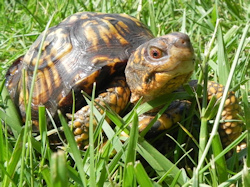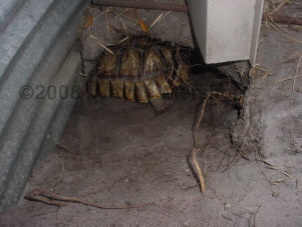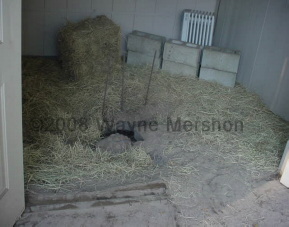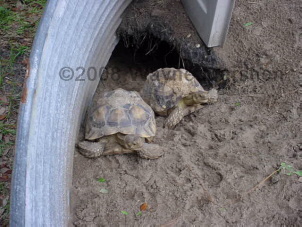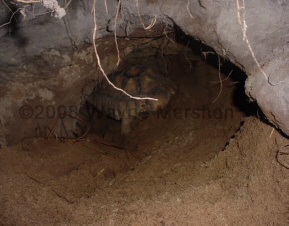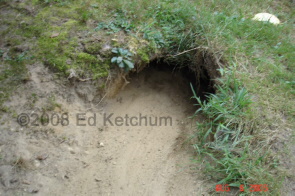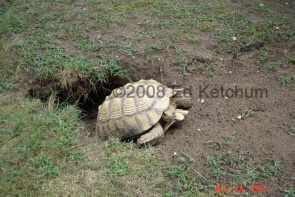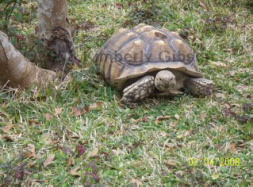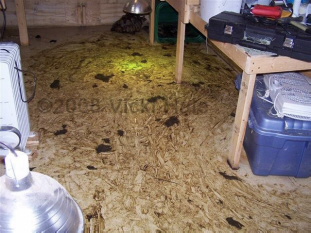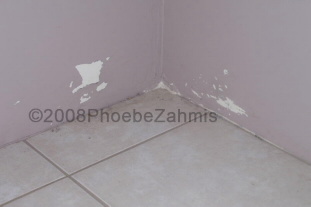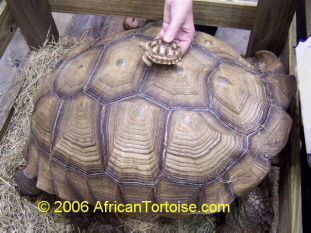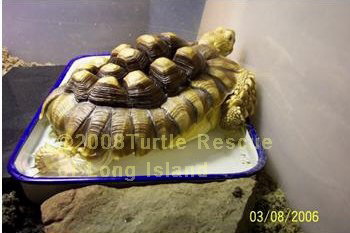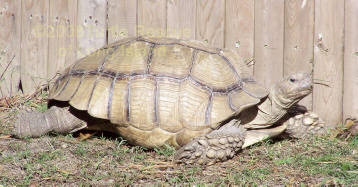|
SULCATA CHALLENGE(Geochelone sulcata) The third largest tortoise in the world Is It the Right Pet for You?Take a look here and see if youíre up for the challenge of owning a tortoise that can grow to be upwards of 150 pounds or more. Sulcata tortoises start out like all other tortoises, tiny and adorable. Probably weighing about 30 grams. Thatís less than the weight of a small cell phone. In the first year that tortoise will most likely triple in size if given proper care. If overfed or given a poor diet like so many are, it will most likely grow to ten times its hatchling size. Sadly it may also by this time have Metabolic Bone Disease (MBD) if a proper diet was not followed. When the Sulcata is young many think they can keep this tortoise in an aquarium. Aquariums are for fish. Aqua means water. Tortoises live on land, not in water. They need good air flow and lots of space for exercise. They need what is called a tortoise table to start out. Are you able to provide enough space to give a Sulcata the space it needs? A hatchling would probably be okay in a 2íx4í area for the first year, but after that will need much more space. Do you have a room large enough to dedicate that space to a tortoise? When it reaches twenty pounds in a couple of years and is over a foot long will you have the space then? Now for their diet. You canít just open a jar of food for these tortoises. They have special needs. They are grazing tortoises so need grazing foods like grasses and weeds. These grasses and weeds need to be fertilizer and pesticide free. They can have a certain amount of high fiber greens like turnip greens, kale, escarole, etc., but the majority (70%) of their diet should be grasses/weeds. Hay is a good way to supplement when grass and weeds are not available. There are online stores like www.carolinapetsupply.com that sell a hay salad that the Sulcata will readily eat when raised on a proper diet. Sulcata should not be fed fruit. Fruit has the potential to cause a parasite bloom in Sulcata so should be avoided. The only fruit that seems to be okay for them is Opuntia cactus pear. The cactus pads themselves are also a great food for them and can be fed about once weekly. There are lots of prepackaged tortoise foods being sold on the market. Read the ingredients. If they are not made with grass/hay/weeds they are not good for your tortoise. Soybean hulls and wheat midlings are fillers, not good nutrition, avoid them. Pretty colors of pellets donít make them a good food. Donít waste your money. Now for the clean up! Have you ever cleaned up after a horse? Well you may want to visit a stable for a few days before deciding on owning a Sulcata. They eat like a horse and they poop and urinate like one too. Most Sulcata will poop every day. This is not so much of a problem when you can keep them outside, but when you have to clean up after them on a daily basis in your home itís not so easy. Itís quite messy. They donít care that you have to clean it up and they donít usually leave it in a neat pile for you. They like to drag it around and smear it all over, and are especially fond of getting it into every nook and cranny of their shells, so you need to be prepared to give a good soak and cleaning to keep your tort clean. When they urinate, itís like a small river. Scooping up a good part of the substrate is a good way to clean up, but be prepared to keep replacing that substrate. That brings us to soaking. Many tortoises do not like to be soaked. They donít like the water very much, but to keep them hydrated itís important to give them a soak at least once a week in warm tepid water (baby bath warm). Do you have a bathtub you donít mind soaking your tortoise in? If not you will need a large plastic tub that you can haul water in to soak the tortoise in and find a place that you donít mind dumping the poopy water. Oh, did I mention that most tortoises like to poop in their soak? Not something you want to dump in the kitchen sink, or the bathtub for that matter. Okay, letís cover the backyard habitat. If youíre going to have a Sulcata you will have to make a secure outdoor habitat. When the tortoise is under twenty pounds a stockade fence will most likely hold this tortoise in, but beyond that size you will need reinforced fencing as well as a barrier dug a foot or so into the ground. These are burrowing tortoises and can dig, so the entire enclose will need a barrier to prevent the tortoise from escaping. Chain link fencing has been taken down by these tortoises, and they have been known to push their way under them, so not good for enclosures. Itís best to have a solid construction fence that they cannot see through. If they can see the other side, they want to get to the other side. Grass is always greener and all that. Either a cement poured base under the fencing along the perimeter or solid landscape timbers buried under the perimeter of the fencing will be needed. Itís also a good idea to have a 12-18Ē board run across the gate opening of your yard. Many tortoises have escaped yards through gates that have either been left open or the tortoises have rammed them hard enough to force them open and escaped. I cannot tell you how many times I have been contacted by frantic keepers whose tortoises were missing from their yards. The yard will also need a good shelter for the tortoise to get out of the elements. A large dog igloo works well, but if you plan on leaving your tortoise outside at night youíll want something you can close your tortoise into and lock it up so itís safe from any predators. Youíll also want something you can hang a heater like a ceramic heat emitter in. If you have a larger shed or garage you can provide a heat mat or wall heater for cooler nights. An outside water source is also necessary. Something large enough for the tortoise to soak in, but not too deep that he can drown in. This water needs to be changed out daily to avoid any mosquito larvae and to make sure thereís no poop left in the water after they soak. Small kiddy pools with one side cut out can work well for larger tortoises, or childrenís round snow saucers can work well also. For really small torts a Frisbee flipped upside down also works well. Whatever you use you have to be prepared to clean that water daily. The habitat will need to be planted heavily with weed seeds as well as grass seed and will not be able to fertilized or treated with pesticides. You have to be willing to let any area of your lawn that your tortoise will roam on go organic. If you have any prized plants or shrubs you cannot have them in the Sulcata enclosure, they will be destroyed. Any plants that are not safe, not toxic or edible will have to be removed. There is an extensive Edible Landscaping list on the African Tortoise website www.africantortoise.com which is advisable to visit so you know what plants can stay in the enclosure and which have to go. The next thing to consider is if you have a dog or a cat. Tortoises do not mix well with dogs or cats. Most people think of dogs and cats with tortoises and the damage done to the tortoises. This is very true. There have been countless cases of tortoises mauled by the family pet that had lived harmoniously with that very tortoise for years until one day when it decided it looked like a great chew toy. However a Sulcata tortoise is a strong tortoise and they have the ability to ram, and ram fast. There have been quite a few cases of broken legs on dogs that were rammed into a wall or cats broken beyond repair from being rammed by a large Sulcata. Care must be taken to keep them away. Vet bills have to be considered and as the Sulcata grows you will have to consider finding a vet that makes house calls unless you are very strong and have the ability to lift that nearly 200 pound tortoise into the back of your truck, you do have a truck right? The most important thing to remember is this is a pet that is for a lifetime. A lifetime commitment. They live for over a hundred years with proper care. You will need to leave a Sulcata in your will to another responsible keeper. Are you up to the task? Be honest with yourself. Itís not a responsibility to be taken lightly. Do not fool yourself into thinking you can keep it for a few years and then donate it to a zoo or nature center. They are filled with them. They donít want any more, and donít have room for more. Do not consider a Sulcata because you think you Ďmightí move in a year or so to a warmer climate. Wait until you make that move and then get that tortoise. So many get the tortoise and never make that move. If after reading this you still feel a Sulcata is the right tortoise for you, and you are prepared to make all the necessary changes to your home necessary to keep a Sulcata, then please do your research and be sure you provide that Sulcata with the best care possible. Do not let it end up like so many with that come into rescues like ours with Metabolic Bone Disease and those awful pyramids, some barely able to carry their own weight. If you get a Sulcata be sure to provide it with a good diet, good UV lighting, some humidity, and lots and lots of space. Take a look at some of the photos on the following pages and see if they donít change your mind as well. These are a few photos of a progression of a three year span of the digging of a burrow by a few Sulcata. Rough guess is the burrow is approximately 5x5 feet with a four foot tunnel down to a main hole, then a tunnel that goes about twenty feet. Thatís how far the tortoise owner went with probing with a piece of rebar before he lost track. The Sulcata in this burrow have raised the floor level of the shed by over two feet in the shed they have dug in and over three feet in the whole area of the pen they dug in. Is your yard equipped to handle that kind of digging? Are you?
Now that youíve seen those photos letís review and be honest with yourself.:
If you answered no to any of these questions a Sulcata is not the pet for you! Want to print this article? Click here
| ||||||||||||||||||||||
